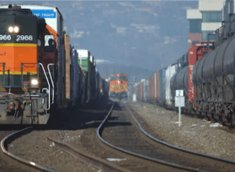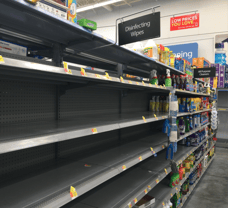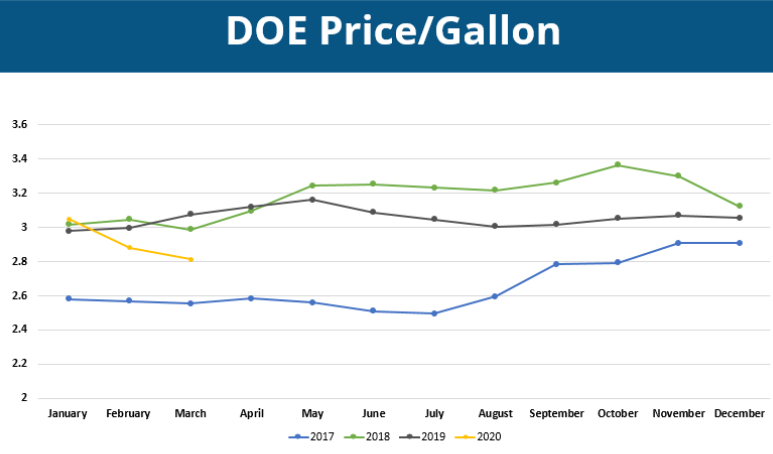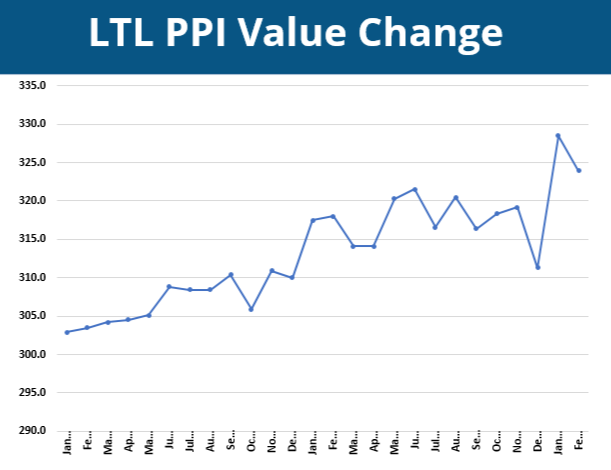
The Less-than-Truckload market is more stable than other transportation markets at this time, but experiencing the beginnings of a capacity crunch as other modes get squeezed. LTL trends have historically followed Truckload trends. As Truckload spot market prices continues to rise, LTL will not be too far behind. However, not all carriers have the resources to weather this storm.
Beaver Express, a 77 year old carrier with over 200 rigs ceased operation Monday (3/23/2020). President Mike Stone admits the business had been on unstable footing for a while but rising insurance costs, plummeting oil prices, and the pandemic were too much to overcome. Beaver Express had much of their operations devoted to hauling oilfield equipment and when prices plummeted, US oil fields scaled back.
As more manufacturers and distributors cease operations either for quarantine purposes or because they cannot continue under an economy that is projected to decline by 24% in the second quarter alone, carriers need to diversify their revenue streams. I do not expect Beaver Express to be the last LTL carrier to succumb to the hardships facing the industry.

China is moving more and more containers out of their ports each day. However, the containers are now moving into highly uncertain markets in the US and Europe. As coastal cities are slowing down and businesses across the country are scaling back operations, the demand for raw materials and goods from China is low. Gene Seroka, Chief of Port of Los Angeles says he does not believe the port will see disruptions like we saw in China as people became sick or quarantined. However, regardless of the port operating at full capacity, it can be argued that the rest of the supply chain across NA is not operating at 100%. Additionally, the Port of Houston has suspended two main container terminals after a worker tested positive for COVID-19.
US ports are bracing for a flood of containers in the coming weeks, but it is unsure whether the demand and infrastructure is going to be there to meet the ships as they dock. (Wall Street Journal)
Average price to ship a 40’ Container from Shanghai to New York is up 21% from a year ago and 7% in the last week (Drewry Shipping Consultants).


FedEx and UPS arefully operational although transit times are suffering as people move to more online ordering as they practice social distancing. UPS, FedEx, and DHL have suspended their guaranteed service refunds until further notice. We have yet to witness any surging in domestic parcel rates. While the two major parcel giants in the US (UPS & FedEX) seem well-positioned to push through the pandemic unscathed, they still face many of the same hurdles as other carriers. UPS is doing it with a new CEO at the helm, Carol Tome former CFO of Home Depot and member of the UPS Board. FedEx is pushing forward with a new CFO, Mike Lenz, whose previous capacity was as the Corporate Vice President and Treasurer for FedEx.

 Week ending 3/21/2020 saw North American intermodal traffic fall nearly 10% (compared to the same week in 2019) as a result of weakening demand caused by COVID-19. Overall year-to-date Intermodal volume is down 6.5% compared to the same time last year. The biggest contributor to the decline in volume is lack of materials and goods hitting ports as China’s output was decimated by COVID-19 earlier this year. As China ramps up production, we expect to see intermodal volumes pick up, but as long as the US demand continues to decline, there are not high expectations for intermodal to get back to where it needs to be any time soon.
Week ending 3/21/2020 saw North American intermodal traffic fall nearly 10% (compared to the same week in 2019) as a result of weakening demand caused by COVID-19. Overall year-to-date Intermodal volume is down 6.5% compared to the same time last year. The biggest contributor to the decline in volume is lack of materials and goods hitting ports as China’s output was decimated by COVID-19 earlier this year. As China ramps up production, we expect to see intermodal volumes pick up, but as long as the US demand continues to decline, there are not high expectations for intermodal to get back to where it needs to be any time soon.


Better than 60% of air freight between the US and Europe was moved in the bellies of Passenger flights. With the major commercial airlines grounding between 20-75% of their fleets, air freight has taken catastrophic hits causing meteoric rises in pricing with many shippers and freight forwarders turning to cargo charters to move
As an example of the current volatility in the air freight market, we have seen some air freight prices in the past week surge by as much as 50%. Air freight from Bangalore and Chennai, India to LAX or ORD is hovering around $6/kg and Frankfurt to ORD is around $7/kg if you can find the space.goods. Many airlines including American, Delta, Qantas, & mores are beginning to fly their commercial passenger jets as cargo haulers. It is unknown at this time if it will be enough to stabilize the Air Freight Market (WSJ, March 23, 2020).


Volumes are surging as companies are paying ballooning rates to get their goods out of factories, warehouses, and distribution centers to store shelves. Carrier rejections increased 8% over the week ending 3/21/2020 as carriers find themselves in the position to reject contract loads and work within the spot market. This has led to the biggest disruption in the supply chains for North American businesses as many are having their loads rejected or forced to pay rates much higher than their contracted rates. All predictions point to this volume surge being temporary as the economy begins to constrict because this volume surge is almost entirely consumer driven.

This is the national average for diesel fuel prices across the United States. There is no reason to believe in a large fluctuation in this price in the near future.
 The Producer Price Index measures trends in pricing from the perspective of sellers not buyers. It is the culmination of thousands of data points compiled by the Bureau of Labor Statistics. There is no reason to believe the current trend will change in the near future.
The Producer Price Index measures trends in pricing from the perspective of sellers not buyers. It is the culmination of thousands of data points compiled by the Bureau of Labor Statistics. There is no reason to believe the current trend will change in the near future.

The above table is provided by DAT and illustrates the sharp upturn spot markets have taken in what some are calling “Pandemic Trucking.” The current trends show this continuing for another few weeks and returning to a more predictable state provided COVID-19 cases begin to fall and quarantines are lifted. However, we will be entering produce season soon and with China increasing exports, the spot market may be elevated for some time to come.

- Wall Street Journal Logistics Report
- Freightwaves
- DAT
- We are also compiling data we are receiving directly from carriers






